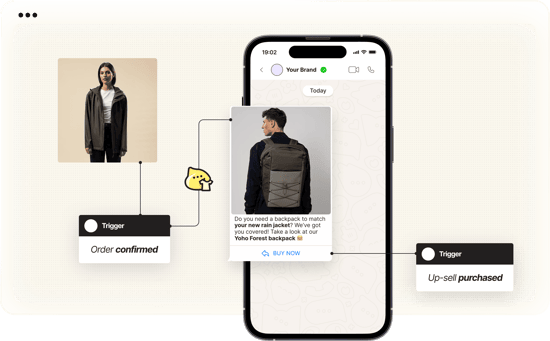Table of Contents
What Is Conversational Commerce?
Conversational commerce is the use of messaging platforms, chatbots, and voice assistants to connect with customers across the entire customer journey — from product discovery and purchase to post-sale support and retention.
Think of it as moving your digital storefront into chat apps like WhatsApp, Facebook Messenger, or even web-based live chat. But it’s more than live support — it’s about building two-way conversations that feel personal, helpful, and timely.

Today’s consumers expect brands to be available instantly, 24/7, and on their preferred channels. Conversational commerce delivers on that expectation — in a way that email, forms, or clunky websites can’t.
Why Conversational Commerce is worth investing in now
This isn’t about jumping on a trend. It’s about solving actual marketing and support challenges — using tools that are ready to deploy today.
1. Higher open and conversion rates
-
WhatsApp messages get up to 90% open rates, far beyond typical email campaigns.
-
Brands using conversational messaging see conversion rate increases of up to 10×.
2. Lower support costs
-
AI-powered chatbots handle FAQs and simple requests 24/7.
-
Brands report significant lower customer service costs after implementation.
3. Improved customer satisfaction
-
The majority of consumers who interact with businesses via WhatsApp rate it as a positive experience.
-
Live chat and messaging support reduce wait times and frustration.
4. Stronger Personalization
- Integrated with your CRM or shop system, conversations can be tailored to user behavior
- Customers receive product recommendations, reorder reminders, and targeted offers — all based on their actual preferences.
5. Omnichannel campaign orchestration
-
Sync messaging, email, and offline data through one unified customer profile.
-
Trigger personalized journeys across touchpoints — all without annoying duplication.
5 Conversational Commerce use cases that work today
These are not future dreams — brands are using them right now.
1. Abandoned cart recovery via WhatsApp
Send a quick WhatsApp message when a customer leaves products in their cart.
With a direct checkout link, this channel converts abandoned carts far better than email.

2. Customer support via AI Agent (chatbots)
AI agents answer FAQs, track orders, initiate returns — even at 2 a.m. Hand off to human agents when needed, all in the same thread.

This reduces ticket volume while improving customer satisfaction and resolution speed.
3. AI-powered product recommendations
Think of it like a digital personal shopper.

4. Transactional messaging (and re-orders)
Send order confirmations, delivery updates, and re-order prompts in chat.

5. Omnichannel CRM integration
Connect WhatsApp to your CRM, CDP, and shop system. That way:
-
If someone buys in-store, you can message them post-purchase.
-
If they abandon a cart online, you can follow up on WhatsApp with personalized products.
-
If they chat with support, your marketing team sees that context in their next campaign.
Conversational Commerce vs Traditional Channels
| Channel | Open Rate | Response Time | Personalization | Interactivity |
|---|---|---|---|---|
| ~20% | Hours to Days | Medium | Low | |
| Phone | N/A | Long wait | Medium | Medium |
| Live Chat | Instant | Instant | High | High |
| 70–90% | Instant | High | High |
What’s next for Conversational Commerce?
While today’s tools are powerful, the future will unlock even more:
- Smarter AI Assistants: Holding multi-turn, human-like conversations.
- Voice & AR Shopping: Asking Alexa to find outfits — or previewing furniture in your home through AR in chat.
- Deeper Integrations: Linking messaging apps directly to loyalty programs, payments, and customer behavior in real time.
But here’s the key: You don’t need to wait. Most of the value is available now.
Conclusion: now is the time for Conversational Commerce
E-commerce and DTC brands across Europe are already seeing results from conversational commerce:
-
More revenue from abandoned cart recovery.
-
Better CX with faster, more helpful support.
-
Higher retention through personalized re-engagement.
-
More efficient campaign orchestration across channels.
If you’re a CMO, CRM lead, or performance marketer tired of low email open rates, fragmented campaigns, and slow support — conversational commerce is the upgrade you’ve been waiting for.
It’s not a buzzword. It’s a better way to do business.
Want to see it in action?
We help leading DTC and retail brands integrate conversational commerce into their marketing and support strategies — without overcomplicating your stack.

Book a demo to see how WhatsApp, CRM, and shop systems can work together to drive conversions and customer love.




